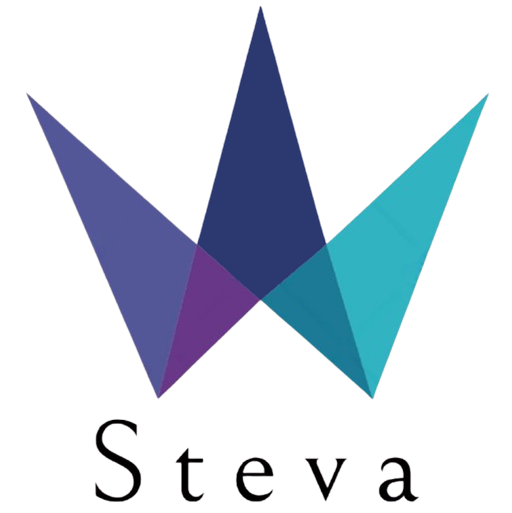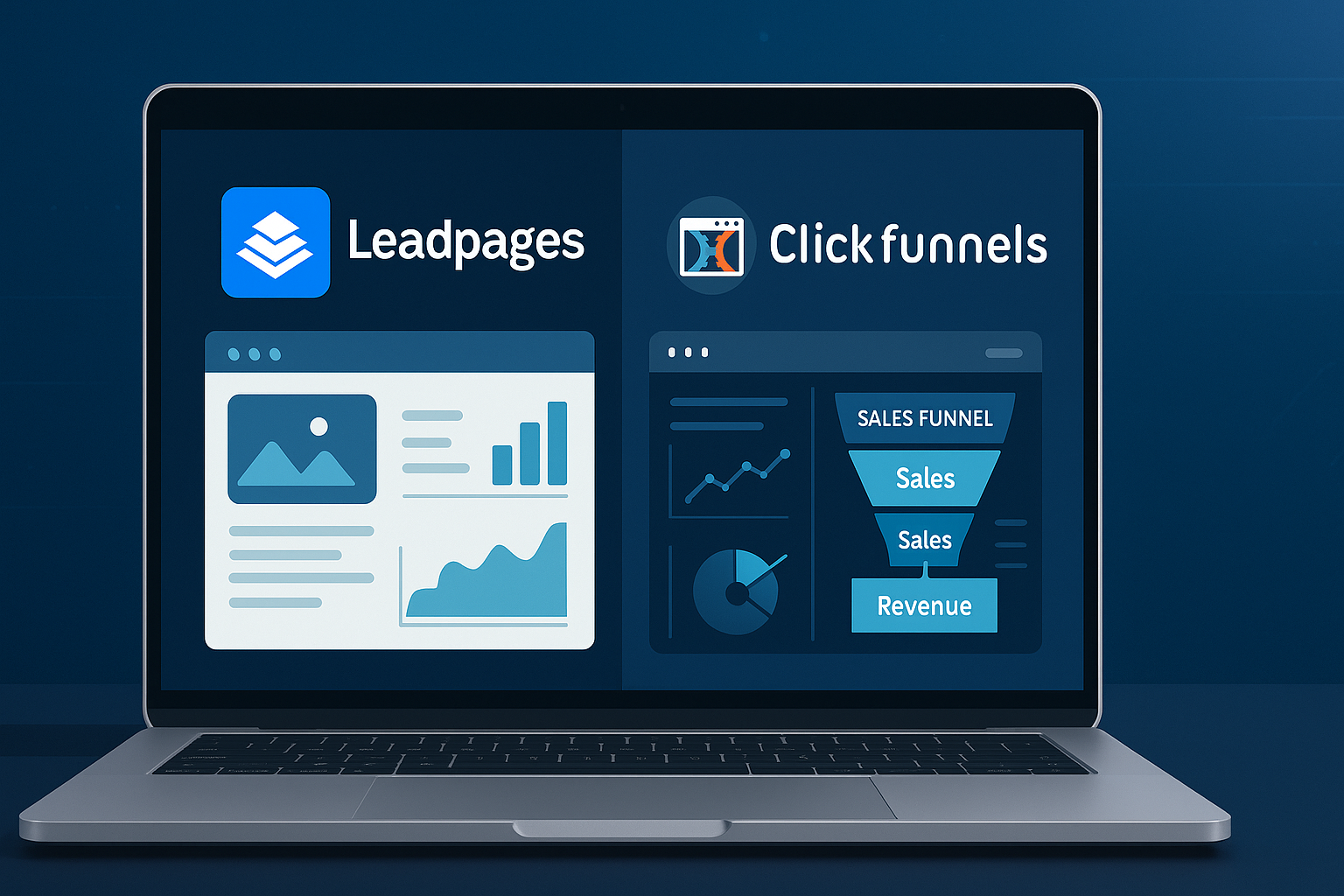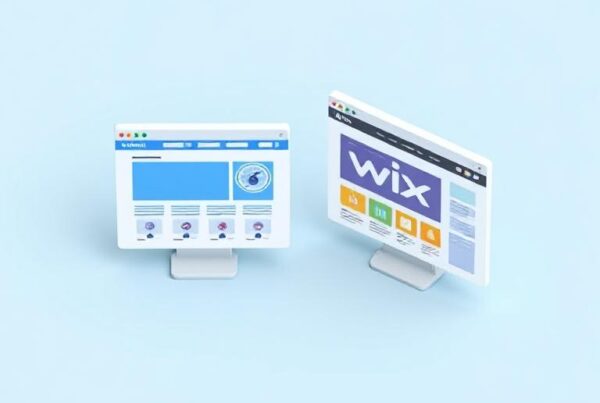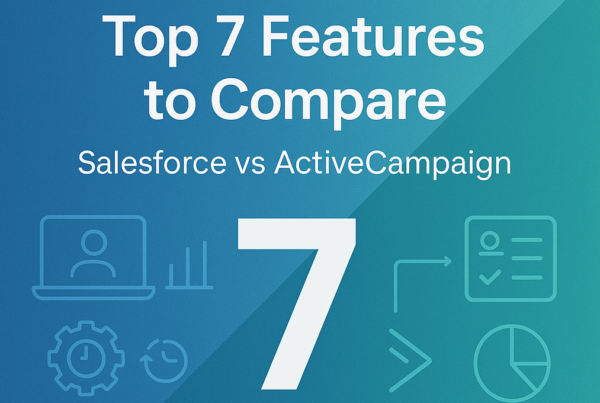Need help choosing between ClickFunnels and Leadpages in 2025? The price tags tell an interesting story: Leadpages costs $37 per month, while ClickFunnels comes in at $97 per month.
Both platforms pack different strengths. Leadpages shines with its easy-to-use interface and library of 200+ professional templates. It makes it ideal for entrepreneurs who want simple landing page tools. ClickFunnels targets 5-year-old businesses with a complete package that combines landing pages, email marketing, and automated sales funnels.
This comparison will guide you to pick the right platform. You might be a solo entrepreneur wanting quick landing pages or a business owner needing detailed sales systems. We’ll break down the pricing, features, usability, and integration options that matter to your specific needs in the Leadpages vs. Clickfunnels debate.
Quick Summary: Leadpages vs Clickfunnels, Who Wins?
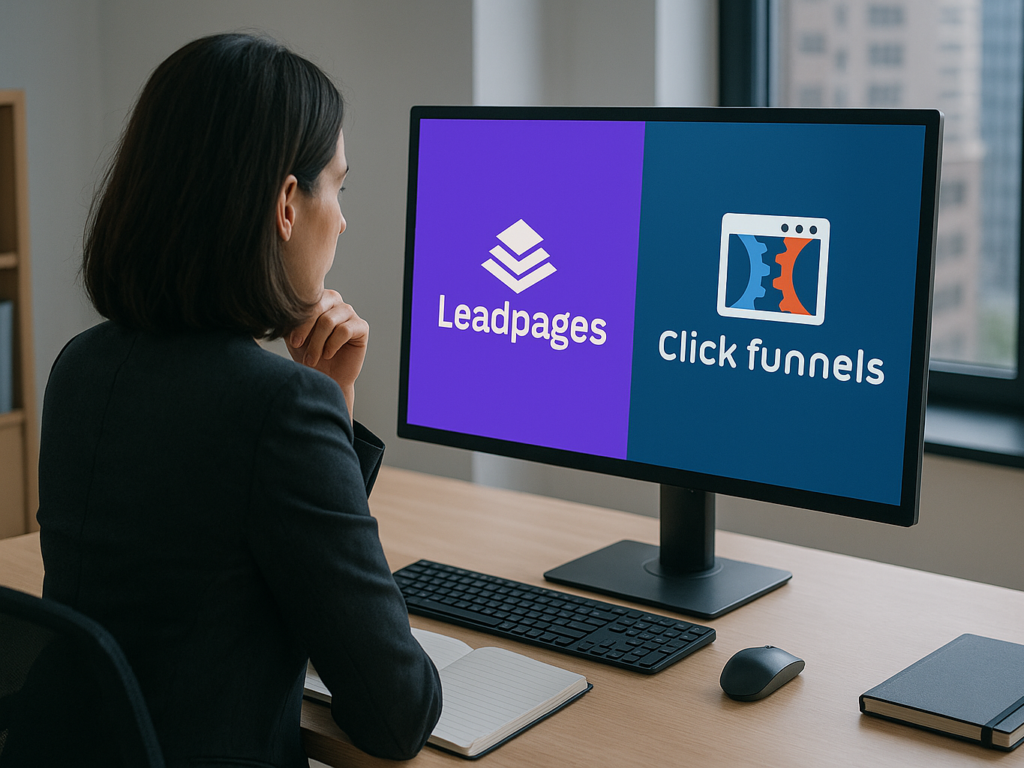
Need help deciding between Leadpages and ClickFunnels? Both platforms excel differently, so your choice depends on your business’s needs.
1. Leadpages for simple landing pages; ClickFunnels for complete sales funnels
Leadpages helps entrepreneurs and small businesses create effective landing pages and websites easily. When it comes to the landing page builder vs sales funnel debate, ClickFunnels shines as the solution for companies that need complete sales funnels with automated sequences. The key difference lies in their core focus: Leadpages builds landing pages, while ClickFunnels creates sales funnels.
2. Best for Beginners: Leadpages
Beginners will find Leadpages more appealing due to its clean interface and straightforward approach. Someone without design experience can create and launch a page within a day. The platform’s accessible interface makes it a perfect fit for newcomers to the field.
3. Best for Sales Funnels: ClickFunnels
ClickFunnels dominates the complete funnel systems market. Users can visualize pages as funnels and immediately access pre-built sales and webinar funnel templates. The platform includes built-in membership sites and email automation (Actionetics) that Leadpages can only offer through third-party integrations.
4. Best Pricing: Leadpages
Leadpages stands out with its affordable Standard plan at $37 per month, while ClickFunnels’ Basic plan costs $97 per month. The cheaper option still packs features that ClickFunnels doesn’t have, like the Leadmeter, alert bars, unlimited traffic, and leads across all plans.
5. Best Features: ClickFunnels
ClickFunnels outperforms Leadpages in feature depth. The platform is an all-in-one solution with built-in payment processing, email marketing, and membership sites. Users get a package of landing pages, email automation, and affiliate program management. Think of it as a complete website and marketing flow in a box. You can create sequences from opt-in pages to order forms without switching between platforms.
Your choice should match your specific needs. Pick Leadpages for quick, affordable landing pages for lead generation and simple marketing tasks. Go with ClickFunnels if you need complete sales funnels with upsells, down sells, and membership features, and you can invest more in these detailed capabilities.
Leadpages vs ClickFunnels: Key Differences
Six fundamental differences between Leadpages and ClickFunnels determine which platform suits your business needs better. These key differences will help you choose the right tool that aligns with your marketing goals and budget.
1. Primary Use: Landing Pages vs Full Funnels
The most crucial difference lies in what each platform does best. Leadpages excels at building high-converting landing pages and websites. Their official site states, “Leadpages’ primary mission is to make it easy to build landing pages and websites.” ClickFunnels takes a different approach. The platform specializes in creating complete sales funnels that guide visitors through a predetermined sequence of pages to maximize conversions. Leadpages builds standalone pages, while ClickFunnels creates interconnected sales systems.
2. Pricing: $37 vs $97 Starting Plans
The price gap between these platforms is quite large:
| Platform | Starting Plan | Mid-tier | Premium |
| Leadpages | $37/month (annual) | $74/month (Pro) | $199/month (Advanced) |
| ClickFunnels | $97/month (Basic) | $297/month (Platinum) | N/A |
Leadpages gives you unlimited traffic and leads on every plan. ClickFunnels’ basic plan restricts you to 20 funnels, 100 pages, and 20,000 visitors.
3. Checkout Tools: 3rd-Party vs Built-In
ClickFunnels comes with its payment processing system. Leadpages users must connect to third-party payment processors like Stripe to handle transactions. It makes a significant difference for businesses that need smooth checkout experiences without extra integrations.
4. Learning Curve: Simple vs Advanced
Leadpages built their platform “so someone with little-to-no design experience can create and publish a page in one day.” In the Leadpages vs Clickfunnels debate, their user-friendly interface makes things simple. On the other hand, ClickFunnels offers more complex features that come with a steeper learning curve. New marketers usually find Leadpages easier to start with.
5. Email Marketing: External vs. Native
Each platform handles email marketing differently. Leadpages needs an external email service provider. ClickFunnels includes email marketing through its Actionetics feature. You can create automated email sequences right inside the platform without other tools.
6. Funnel Logic: Manual Linking vs Automated Sequences
The platforms take different approaches to marketing sequences. Leadpages requires you to build and connect each page manually. ClickFunnels creates automated marketing sequences with preset relationships between pages, including upsells, downsells, and order bumps. This automated funnel logic shows the fundamental difference between these platforms.
These key differences will help you pick the tool that matches your business needs, technical skills, and marketing goals.
Pricing and Value for Money
Money plays a decisive role in choosing between these two platforms. A full picture of pricing shows the most essential differences in how costs are structured and what value you get.
1. Leadpages Plans: Standard, Pro, Advanced
Leadpages markets itself as a more affordable option with three pricing tiers:
- StandardPlann: $37/month (annual billing) or $49/month (monthly)
- Pro Plan: $74/month (yearly billing) or $99/month (monthly)
- Advanced/Conversion Plan: $697/month
Each Leadpages plan includes unlimited traffic and leads, which brings exceptional value, especially when you have growing businesses. The Standard plan has simple landing page creation tools. The Pro plan includes online sales, payments, and A/B testing. You can save up to $300 yearly by choosing annual billing on the Pro plan.
2. ClickFunnels pricing: Basic, Pro, Funnel Hacker
ClickFunnels pricing starts at a higher point but comes with detailed functionality:
- Startup/Basic Plan: $97/month (or $81/month with annual billing)
- Pro Plan: $297/month (or $248/month with annual billing)
These plans offer unlimited funnels, courses, members, contacts, pages, and domains. The core difference is shown in capacity limits. The Startup plan gives you three workspaces and 3 team members. The Pro plan increases this to 10 workspaces and 10 team members.
3. Hidden Costs: Add-ons, integrations, and upsells
Both platforms come with extra costs beyond their advertised prices:
a) Leadpages extras:
- You might need upgrades to access eCommerce features
- Higher-tier plans are needed for multiple domains
b) ClickFunnels extras:
- Email sending costs $0.68 per 1000 emails.
- Video hosting costs $0.10 per video and $10 per 1TB of bandwidth.
- Each integration costs $0.01
4. Winner: Leadpages for affordability, ClickFunnels for all-in-one value
Your specific business needs determine which pricing works best. Leadpages wins in pure affordability at $37/month compared to ClickFunnels’ $97/month starting price. Small businesses or startups will find this price difference significant.
Notwithstanding that, ClickFunnels provides better value if you need detailed sales funnel functionality. ClickFunnels states, “You get what you pay for”. Their platform includes a complete sales funnel system, membership site features, payment gateway integration, and shopping cart functionality that could replace several separate tools.
Both platforms give you a chance to test their features. Leadpages offers a 14-day free trial. ClickFunnels provides 14 days plus a 30-day money-back guarantee.
Features and Funnel Capabilities
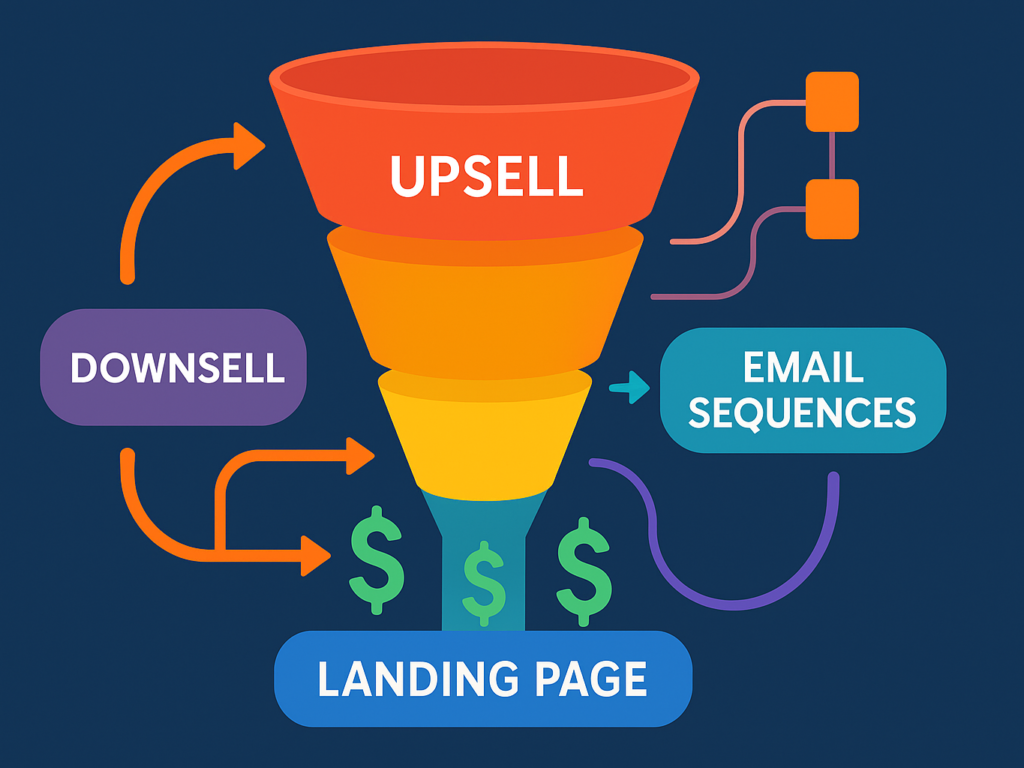
The core features of Leadpages vs ClickFunnels show their different purposes and target users. Each platform has unique tools designed for specific marketing goals.
1. Leadpages: Leadmeter, pop-ups, alert bars
Leadpages stands out with conversion-focused features you won’t find in ClickFunnels. The Leadmeter analyzes page content and compares it to thousands of high-performing pages to predict conversion rates before publishing. This technology reviews four key conversion categories and provides step-by-step guidance to optimize each page element.
Leadpages has versatile alert bars that stick to your page as visitors scroll. These slim, non-intrusive banners promote time-sensitive offers, capture email opt-ins, and direct traffic to landing pages without disrupting the user’s experience. Alert bars work well at the top of desktop pages or the bottom for mobile users.
The platform’s three pop-up forms, click-triggered, timed, and exit-intent, capture leads at crucial points during the customer’s trip.
2. ClickFunnels: Upsells, down sells, order bumps
ClickFunnels shines with its detailed funnel-building capabilities. The platform creates automated upsell pages after the original purchase to increase order value. These one-time offers exist only inside the checkout process.
The platform shows down sells automatically when customers skip an upsell offer. It gives a second chance to capture extra revenue at a lower price point.
Order bumps appear right on checkout pages instead of separate screens. Customers can add complementary products with one click, substantially increasing average transaction values.
3. Email Automation: None vs Actionetics
Leadpages doesn’t have built-in email marketing features. Users need external email service providers for follow-up sequences.
ClickFunnels has built-in email marketing through Actionetics. Users create automated sequences directly in the platform. The internal email system responds to customer actions and creates tailored follow-up experiences without external tools.
4. Membership Sites: Not available vs. Built-in
There’s another key difference in membership functionality. Leadpages lacks native membership site features but connects with platforms like Teachable and Thinkific through Zapier.
ClickFunnels has built-in membership site creation. You can sell courses, drip content, or host subscription-based information libraries in one platform. This integrated system eliminates the need for separate membership software.
Ease of Use and Learning Curve
Your productivity depends on your ability to use a platform beyond its features and pricing. Let’s get into how these competitors compare in terms of user experience.
1. Leadpages: Clean UI, fast setup
Leadpages was designed “so someone with little-to-no design experience can create and publish a page in one day.” The platform’s dashboard shows a clean layout with a left navigation pane that clearly labels all key features. Users can start working right away because of this accessible organization without searching for the tools they need.
The Leadpages drag-and-drop editor needs no coding knowledge, making it “the ideal choice for non-designers looking for a struggle-free experience.” Template selection becomes simple when you can sort options by popularity, conversion rates, or newest additions.
The Leadmeter feature stands out as it “predicts the performance of your page and provides customized tips to maximize conversions.” Marketing newcomers can skip the guesswork entirely.
2. ClickFunnels: More powerful but complex
ClickFunnels delivers “an insanely powerful and easy-to-use drag-and-drop visual editor” but has a steeper learning curve. The platform shows “a more cluttered interface.” Multiple tutorials and promotions appear on the dashboard when you log in, making getting started tricky.
The platform arranges templates by funnel types instead of page types, which works better for users who know sales funnel concepts. Beginners need extra time to learn funnel terminology before they can use this approach effectively.
ClickFunnels rewards the learning investment with deeper customization options and advanced capabilities that surpass Leadpages.
3. Onboarding and Tutorials: FunnelFlix vs Weekly Coaching
Each platform takes a unique approach to helping users learn:
- Leadpages runs guided weekly workshops that help users “master Leadpages faster.” Their help center has detailed how-to resources for technical questions, plus a blog with case studies and marketing advice.
- ClickFunnels provides FunnelFlix, a reliable training library with many tutorials explicitly made for members. This video collection thoroughly explains the funnel system and platform features.
New users will find Leadpages easier because of its accessible interface and gentler learning curve. ClickFunnels suits those ready to invest more time learning to access advanced marketing tools.
Templates and Design Flexibility
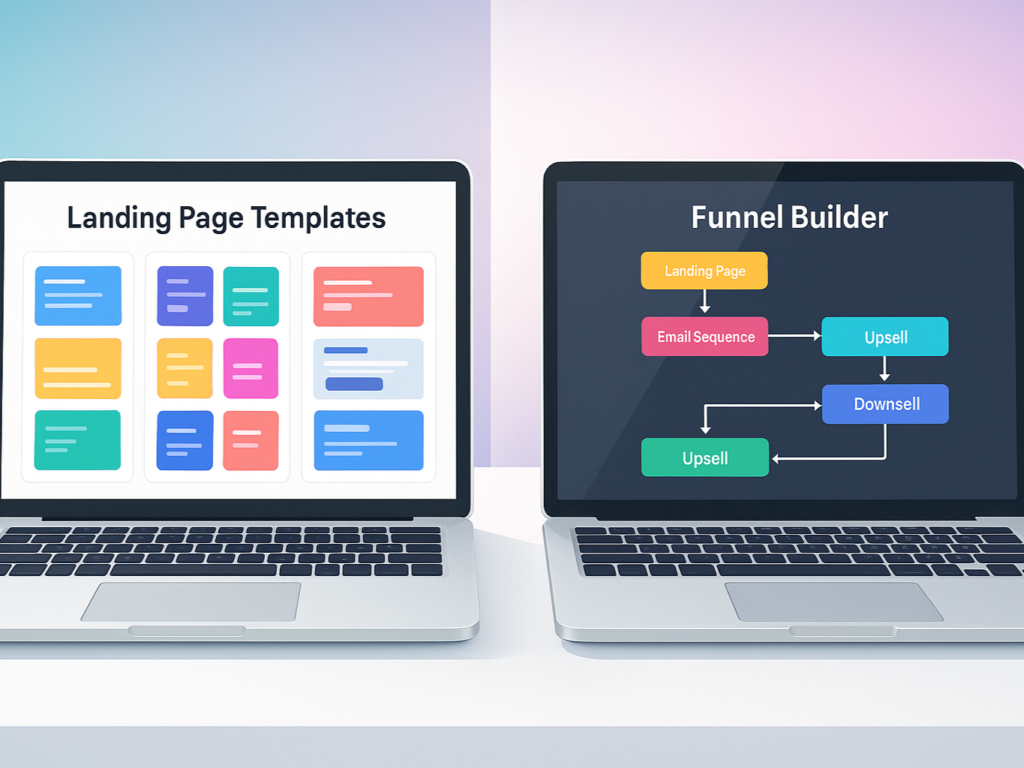
Template variety and design capabilities are vital when choosing a landing page platform. Leadpages vs ClickFunnels take unique approaches to templates and customization that align with their primary goals.
1. Leadpages: 250+ lead-gen templates
Leadpages has an impressive library of over 250 professionally designed templates optimized for lead generation. These templates build on more than a decade of conversion marketing expertise. Users can feel confident about capturing leads and sales. The platform makes finding the right template easy, and you can sort options by popularity, conversion rate, and newest additions.
Leadpages templates shine with their template organization system. The platform lets you filter templates by page type, industry, style, and color. It makes finding designs that match your brand vision a breeze. The section templates add another layer of convenience. You can add them to any existing page to save time while keeping your visual style consistent.
2. ClickFunnels: 100+ funnel-specific templates
ClickFunnels takes a different approach with its over 100 templates. Instead of organizing by page type, templates are grouped by funnel type. You’ll find categories like sales, opt-in, membership, and product launch. It shows ClickFunnels’ emphasis on complete marketing sequences rather than individual pages.
The platform’s marketplace has templates for every industry you can think of. It includes real estate, B2B, ecommerce, SaaS, dentistry, and fitness. ClickFunnels groups its templates based on their purpose: lead generation, event hosting, product launches, or service sales.
3. Customization Depth: Simple vs Advanced
Both platforms feature drag-and-drop editors with WYSIWYG (what you see is what you get) capabilities. The differences become clear in their customization tools.
Leadpages stands out with AI-powered design assistants. Need an image? Just describe what you want; the image generator creates it in seconds. The writing assistant helps, too; it can create an entire landing page copy or improve your headlines and CTAs.
ClickFunnels focuses more on advanced funnel-specific customization. While it has an AI writer for copy generation, it doesn’t match Leadpages’ image generator or conversion prediction tools. Each platform has its strengths; Leadpages excels at simple, AI-assisted design for standalone pages, while ClickFunnels specializes in powerful customization for sales sequences.
Integrations and Tech Stack Compatibility
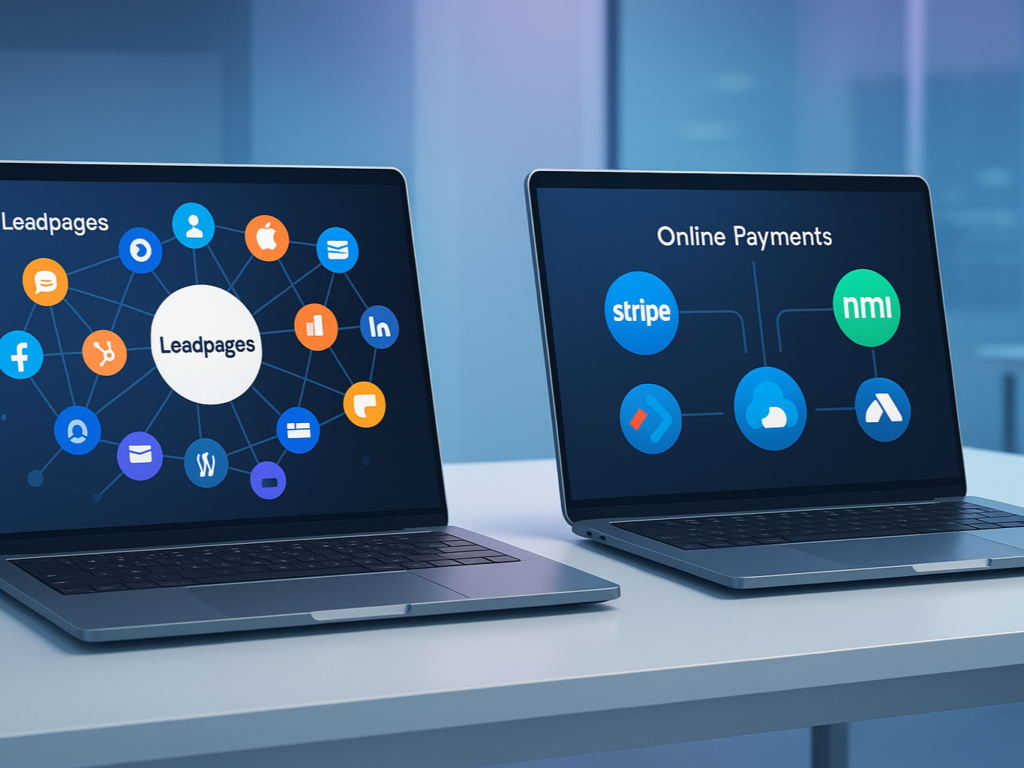
Your marketing platform’s success depends on how well it works with your existing tech stack. Leadpages vs ClickFunnels each have their integration ecosystems that align with what they do best.
1. Leadpages: 100+ native integrations
Leadpages stands out with over 90 different native integrations. This network has all major email service providers, CRMs, webinar platforms, social networks, and Stripe payment processing. The platform naturally connects with popular marketing tools like Google Analytics, MailChimp, ActiveCampaign, and HubSpot.
Leadpages’ Advanced Plan gives you access to premium integrations like Salesforce, Marketo, and Pardot. Because of this broad compatibility, your landing pages can talk to almost any marketing tool you use.
2. ClickFunnels: 50+ integrations with built-in payments
ClickFunnels shines when it comes to payment processing. Its Payments AI feature lets you connect directly with multiple payment gateways, including Stripe, PayPal, and NMI. Thanks to this built-in payment system that creates smooth checkout experiences, you won’t need extra third-party services.
The platform connects to key marketing tools like email providers, CRMs, webinar platforms, and social networks. ClickFunnels’ specialized integrations include Twilio for SMS messaging, calendar embedding options, and fulfillment services like ShipStation and Disk Delivered.
3. Zapier Support: Available on both
Both platforms use Zapier to expand their integration options, which puts them on equal footing. This connection lets Leadpages vs ClickFunnels work with thousands more applications.
Leadpages users need at least one integration with Zapier for proper data flow. ClickFunnels also uses Zapier to expand beyond its native integrations.
Your specific needs will determine the best choice. Pick Leadpages if you need many native connections to your marketing tools. Go with ClickFunnels if built-in payment processing and checkout features matter most to your business.
Support, Training, and Community
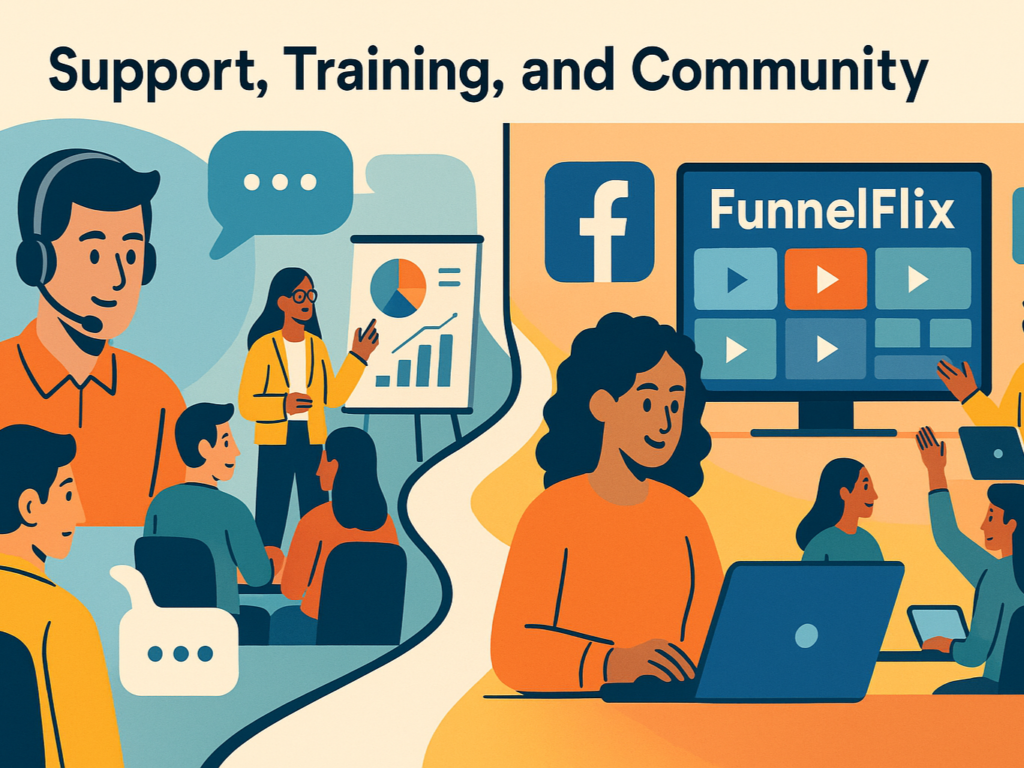
Support and training resources are vital factors when choosing between Leadpages and ClickFunnels. Users need assistance with even the most user-friendly platforms.
1. Leadpages: 24/7 chat, knowledge base
Leadpages offers multi-channel support based on subscription levels. Support teams work from Minneapolis and Victoria, Canada. Pro and Advanced subscribers can access live chat support Monday through Friday during business hours (9 am-5 pm Central time).
Standard plan members can expect email support responses within 24-48 hours. All Leadpages customers can join weekly marketing education training that includes group conversion coaching at no extra cost. This coaching provides excellent guidance, no matter your plan level.
The platform’s complete knowledge base contains well-laid-out self-serve resources that cover everything from the page builder to integrations and analytics.
2. ClickFunnels: FunnelFlix, Facebook groups, live webinars
ClickFunnels has built its support around an extensive training ecosystem. FunnelFlix is the lifeblood of this system, a reliable library of marketing courses and training resources. This Netflix-style platform teaches marketers about funnel building, copywriting, traffic generation, and business strategy.
ClickFunnels users can access premium courses that would cost thousands if bought separately. The “One Funnel Away Challenge” stands out as a 30-day program that guides users through creating their first sales funnel, though it sometimes requires an extra fee.
The platform encourages community growth through active Facebook groups where users share strategies and ask for advice. Email and live chat support changes by subscription level, and chat representatives usually respond within an hour.
Both platforms ended up prioritizing customer success differently. Leadpages focuses on direct support channels and weekly coaching, while ClickFunnels emphasizes extensive training libraries and community building. Your learning style might help you pick the approach that works best.
When to Choose ClickFunnels? (Use Cases)
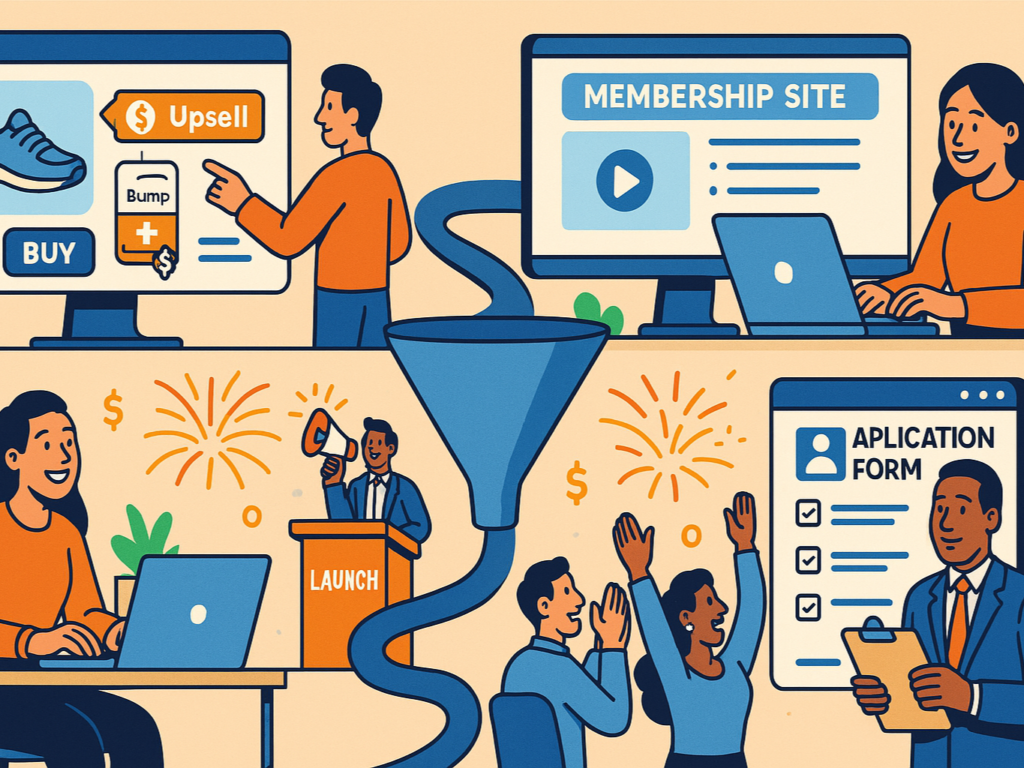
ClickFunnels is the best choice when your business needs complete sales automation to boost marketing results.
The platform works perfectly for eCommerce businesses that need advanced upsell sequences. You can create upsells, downsells, and order bumps right out of the box to maximize revenue without extra integrations. ClickFunnels shines at guiding visitors through preset sequences that turn one-time buyers into loyal customers.
Course creators and coaches will love ClickFunnels’ built-in membership site features. While Leadpages needs third-party tools for membership areas, ClickFunnels gives you everything you need in one place. It is ideal for selling online courses, coaching programs, or subscription-based products.
The platform also works great for businesses that generate leads with physical products. For instance, ClickFunnels co-founder Russell Brunson’s strategy with his book “DotCom Secrets” asks customers to pay shipping costs ($9.95 US, $19.95 international). This innovative lead generation technique gets better quality leads because people commit more up front.
Product launch funnels showcase another area where ClickFunnels stands out. You can build excitement and boost sales for new products through optimized funnel strategies. These carefully designed page sequences guide potential customers through their buying decisions.
Companies with high-ticket services should look at ClickFunnels for its application funnel features that qualify leads before any sales talks happen. It is a valuable tool for businesses offering consulting, agency services, or premium products above $1,000.
Of course, ClickFunnels delivers the most value when you need complete funnel automation instead of basic landing pages. It is especially true if your business model uses sequential offers, membership content, or complex customer paths.
When to Choose Leadpages? (Use Cases)
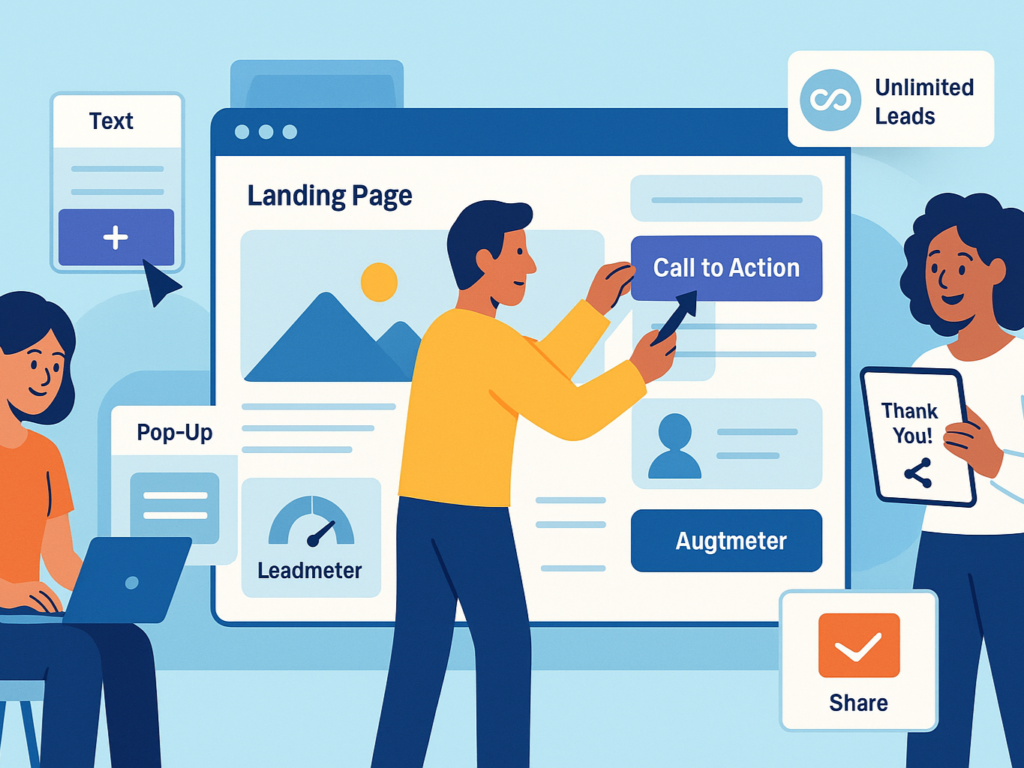
Looking at Leadpages for your business? The platform shines when you need simple, focused lead generation rather than complex sales systems.
Small business owners and entrepreneurs who want to build landing pages that work will find Leadpages a perfect fit. The drag-and-drop visual editor helps create landing pages quickly and easily. It makes it ideal for anyone who needs to launch campaigns fast.
Businesses can collect leads without worrying about visitor or lead count limits. While other platforms charge based on traffic volume, Leadpages gives unlimited traffic and leads on all subscription plans. It makes it an economical solution as your business grows.
Professionals who lack design or coding skills but need attractive pages that convert will love Leadpages. The platform’s Leadmeter feature predicts your page’s performance before it goes live. It takes the guesswork out of optimization.
Leadpages shines when you need to:
- Run cost-effective webinars using built-in templates with embedded presentations and chat boxes for Q&A
- Add professional pop-ups with clear CTAs to your blog
- Set up high-converting landing page forms using proven templates
- Send content upgrades to new subscribers right after they opt in
- Get email subscribers through text messages instead of website visits
- Create sales pages from customizable templates
- Build thank you pages that encourage social sharing post-subscription
Leadpages ended up being the best choice for users who value simplicity and affordability. As their official statement says, “Whatever you do, whatever industry you’re in, Leadpages is designed to transform your passion into a profitable business.” The platform gives entrepreneurs a fast, robust solution to convert leads and close sales without dealing with complex funnel systems.
Leadpages vs Clickfunnels: pros and cons
Let me break down both platforms’ key strengths and limitations to help you make the final decision.
1. Leadpages
Pros:
- Affordability: Starting at just $37/month with annual billing
- Unlimited Resources: No restrictions on traffic or leads across all plans
- User-Friendly: Pages are quick to create, even for non-technical users
- Leadmeter Technology: AI-powered conversion prediction tool
- Reliability: The Google Cloud platform ensures minimal downtime with quick fixes
Cons:
- Limited Customization: Standard templates can’t be fully edited
- Sluggish Editor: The drag-and-drop builder can be wonky at times
- No Native Checkout: Third-party integrations are needed for payments
- Limited A/B Testing: Higher-tier plans are required for this feature
- No Enterprise Options: Large organizations might find it limiting
2. ClickFunnels
Pros:
- Complete Funnel System: Pre-designed templates for entire sales sequences
- Built-in Features: Native payment processing, email automation, and affiliate tools
- Membership Sites: Gated content creation without extra software
- Upsell Capabilities: One-click upsells, down sells, and order bumps
- Expert-Created: Renowned funnel marketing specialists developed the platform
Cons:
- Higher Cost: $97/month starting price with a funnel and visitor limits
- Steeper Learning Curve: The complex interface needs time to master
- Reliability Concerns: Downtime happens more often than at Leadpages
- Additional Fees: Email sending costs $0.68 per 1000, and video hosting requires an extra payment
- Overwhelming: Beginners might struggle with the feature-rich interface
Your business priorities should guide your choice. Small businesses and startups will find Leadpages affordable and straightforward. ClickFunnels works better for established businesses that are ready to implement complex marketing strategies. Both platforms have helped countless entrepreneurs succeed online.
Comparison Table: Leadpages Vs ClickFunnels
| Aspect | Leadpages | ClickFunnels |
| Starting Price | %37/month | $97/month |
| Core Purpose | Landing pages and websites | Complete sales funnels |
| Templates | 250+ lead-gen templates | 100+ funnel-specific templates |
| Traffic/Lead Limits | Unlimited in all plans | Limited (20k visitors on starter plan) |
| Payment Processing | Needs third-party integration | Built-in checkout system |
| Email Marketing | External integration required | Built-in (Actionetics) |
| Membership Sites | Not available | Built-in functionality |
| Learning Curve | Simple to use, ideal for beginners | More complex with steeper learning curve |
| Unique Features | Leadmeter, Alert bars, Pop-ups | Upsells, Downsells, Order bumps |
| Native Integrations | 100+ | 50+ |
| Support Options | 24/7 chat (Pro/Advanced), Email support | Live chat, FunnelFlix training |
| Best Suited For | Simple landing pages, Lead generation | Complete sales funnels, eCommerce |
| A/B Testing | Available in higher-tier plans | Available in all plans |
| Customization Level | Simple | Advanced |
| Training Resources | Weekly coaching, Knowledge base | FunnelFlix, Facebook groups, Webinars |
Final Thoughts
Picking between Leadpages and ClickFunnels comes down to your business needs and goals. Leadpages is perfect for entrepreneurs who want simple, affordable landing page creation at $37 per month. The platform’s unique Leadmeter feature optimizes AI-powered conversion with unlimited traffic and leads.
ClickFunnels works better for businesses that need detailed sales funnels. The platform costs $97 monthly but includes payment processing, email automation, and membership site features. Your marketing system runs naturally on one platform, which removes the need for extra tools.
Take time to think about your primary goals. Leadpages makes sense if you need professional landing pages and want to keep costs low. ClickFunnels is the right choice when you need advanced sales funnels that include upsells, downsells, and membership areas.
You can try both platforms for 14 days to test their features before deciding. The best choice will match your marketing needs and technical expertise.
FAQs on leadpages vs clickfunnels
Q1. Can Leadpages build sales funnels?
Not really. Leadpages focuses on standalone pages, not multi-step funnels. If you compare Leadpages vs ClickFunnels, ClickFunnels wins when building complete sales funnels with upsells, email sequences, and automation. Leadpages is a great landing page builder, but it lacks funnel-building tools. So, if you aim to guide users through a series of steps, ClickFunnels is the better choice.
Q2. Is ClickFunnels worth the price?
It depends on your needs. If you’re building simple pages, it might feel expensive. But if you’re managing upsells, downsells, automated emails, and checkouts, ClickFunnels pricing makes sense. It’s an all-in-one tool built for businesses that need serious funnel infrastructure. For marketers looking to scale and automate the buyer journey, the investment often pays off, especially when compared to stitching together multiple tools.
Q3. Which has better templates: Leadpages or ClickFunnels?
If you’re looking for design flexibility and visual polish, Leadpages templates are more modern and customizable. You can filter by industry, goal, or style, making it easier to match your brand. ClickFunnels templates are functional but often feel outdated unless you customize them heavily. For landing pages specifically, Leadpages has the edge. However, for funnel flows and conversion-focused sequences, ClickFunnels still holds its ground.
Q4. What’s better: a landing page builder or a sales funnel tool?
That depends on your business model. In the landing page builder vs. sales funnel conversation, landing page builders like Leadpages are great for single offers or lead generation. However, sales funnel tools like ClickFunnels are better for multi-step campaigns, upsells, and maximizing lifetime customer value. Choose based on whether you capture leads or guide them through a complex journey toward purchase.
